 |
| October 02, 2012 | Volume 08 Issue 37 |
Materials News & Products
Designfax weekly eMagazine
Archives
Partners
Manufacturing Center
Product Spotlight
Modern Applications News
Metalworking Ideas For
Today's Job Shops
Tooling and Production
Strategies for large
metalworking plants
Engineering challenge: Which 3D-printed parts will fade?
 How does prolonged exposure to intense UV light impact 3D-printed plastics? Will they fade? This is what Xometry's Director of Application Engineering, Greg Paulsen, set to find out. In this video, Paulsen performs comprehensive tests on samples manufactured using various additive processes, including FDM, SLS, SLA, PolyJet, DLS, and LSPc, to determine their UV resistance. Very informative. Some results may surprise you.
How does prolonged exposure to intense UV light impact 3D-printed plastics? Will they fade? This is what Xometry's Director of Application Engineering, Greg Paulsen, set to find out. In this video, Paulsen performs comprehensive tests on samples manufactured using various additive processes, including FDM, SLS, SLA, PolyJet, DLS, and LSPc, to determine their UV resistance. Very informative. Some results may surprise you.
View the video.
Copper filament for 3D printing
 Virtual Foundry, the company that brought us 3D-printable lunar regolith simulant, says its popular Copper Filamet™ (not a typo) is "back in stock and ready for your next project." This material is compatible with any open-architecture FDM/FFF 3D printer. After sintering, final parts are 100% pure copper. Also available as pellets. The company says this is one of the easiest materials to print and sinter. New Porcelain Filamet™ available too.
Virtual Foundry, the company that brought us 3D-printable lunar regolith simulant, says its popular Copper Filamet™ (not a typo) is "back in stock and ready for your next project." This material is compatible with any open-architecture FDM/FFF 3D printer. After sintering, final parts are 100% pure copper. Also available as pellets. The company says this is one of the easiest materials to print and sinter. New Porcelain Filamet™ available too.
Learn more and get all the specs.
Copper foam -- so many advantages
 Copper foam from Goodfellow combines the outstanding thermal conductivity of copper with the structural benefits of a metal foam. These features are of particular interest to design engineers working in the fields of medical products and devices, defense systems and manned flight, power generation, and the manufacture of semiconductor devices. This product has a true skeletal structure with no voids, inclusions, or entrapments. A perennial favorite of Designfax readers.
Copper foam from Goodfellow combines the outstanding thermal conductivity of copper with the structural benefits of a metal foam. These features are of particular interest to design engineers working in the fields of medical products and devices, defense systems and manned flight, power generation, and the manufacture of semiconductor devices. This product has a true skeletal structure with no voids, inclusions, or entrapments. A perennial favorite of Designfax readers.
Learn more.
When glass or plastic can't cut it: Transparent ceramics solve critical design challenges
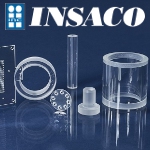 Complex designs are still possible when grinding and polishing Fused Silica or Sapphire. Ceramic properties such as wear, abrasion resistance, and strength of these optical materials can be a designer's dream solution when high temperatures or severe environments rule out standard optical glass or plastic. INSACO is a machine shop specializing in ultra-hard and extreme materials.
Complex designs are still possible when grinding and polishing Fused Silica or Sapphire. Ceramic properties such as wear, abrasion resistance, and strength of these optical materials can be a designer's dream solution when high temperatures or severe environments rule out standard optical glass or plastic. INSACO is a machine shop specializing in ultra-hard and extreme materials.
→ Contact Jackson Evans, Sales Engineer at INSACO jpe@insaco.com.
→ Learn more about INSACO materials and capabilities.
New aero and defense PEKK-based FDM polymers from Stratasys
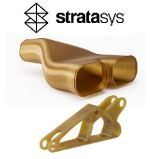 Stratasys has partnered with top aerospace and defense companies to develop two newly qualified materials for 3D printing. Antero 800NA is a PEKK-based FDM polymer with excellent physical and mechanical properties for demanding applications. Antero 840CN03 is a high-performance PEKK-based FDM polymer with electrostatic dissipative (ESD) properties. These new advanced industrial solution materials were rigorously qualified in collaboration with Northrop Grumman, Boeing, Blue Origin, Raytheon, Naval Air Systems Command, the National Institute for Aviation Research, United States Air Force, BAE, and Stratasys Direct Manufacturing.
Stratasys has partnered with top aerospace and defense companies to develop two newly qualified materials for 3D printing. Antero 800NA is a PEKK-based FDM polymer with excellent physical and mechanical properties for demanding applications. Antero 840CN03 is a high-performance PEKK-based FDM polymer with electrostatic dissipative (ESD) properties. These new advanced industrial solution materials were rigorously qualified in collaboration with Northrop Grumman, Boeing, Blue Origin, Raytheon, Naval Air Systems Command, the National Institute for Aviation Research, United States Air Force, BAE, and Stratasys Direct Manufacturing.
Learn more.
EOS expands its Nickel superalloys for 3D printing
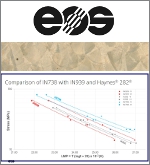 EOS, a leading supplier of manufacturing solutions for industrial 3D printing, has added two new metal additive manufacturing materials: EOS NickelAlloy IN738 and EOS NickelAlloy K500, both delivering excellent performance, part properties, and value to a variety of industries that leverage EOS Laser Powder Bed Fusion (LBPF) 3D-printing technology. The IN738 superalloy is aimed at high-strength, high-stress energy and turbomachinery applications, while the K500 superalloy is a cost-effective, corrosion-resistant option for chemical, maritime, and space industries.
EOS, a leading supplier of manufacturing solutions for industrial 3D printing, has added two new metal additive manufacturing materials: EOS NickelAlloy IN738 and EOS NickelAlloy K500, both delivering excellent performance, part properties, and value to a variety of industries that leverage EOS Laser Powder Bed Fusion (LBPF) 3D-printing technology. The IN738 superalloy is aimed at high-strength, high-stress energy and turbomachinery applications, while the K500 superalloy is a cost-effective, corrosion-resistant option for chemical, maritime, and space industries.
Learn more.
CNC machining: How to avoid high costs on thin walls
 Parts that are light and strong are crucial to nearly every industry. To achieve better performance without risking part failure, parts must maintain a specific wall-height-to-thickness ratio and wall-height-to-length ratio. Additionally, some geometries and supports can support thin walls to achieve a lighter component weight. Dive deeper into the cost drivers behind CNC-machined thin walls in this Xometry design-for-manufacturing article.
Parts that are light and strong are crucial to nearly every industry. To achieve better performance without risking part failure, parts must maintain a specific wall-height-to-thickness ratio and wall-height-to-length ratio. Additionally, some geometries and supports can support thin walls to achieve a lighter component weight. Dive deeper into the cost drivers behind CNC-machined thin walls in this Xometry design-for-manufacturing article.
Read the full article.
Eco-friendly thermoplastic: Light, rigid, strong, damping
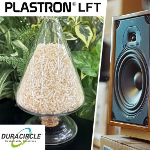 Polyplastics has launched PLASTRON® LFT (Long Fiber-Reinforced Thermoplastic) RA627P, an eco-friendly composite of polypropylene (PP) resin and long cellulose fiber that delivers low density, high specific rigidity, high impact strength, and excellent damping for a range of applications including audio components and housings of industrial components. LFT exhibits 10% lower density than 30% short glass fiber-reinforced PP resin, roughly the same flexural modulus, and a specific rigidity that is higher.
Polyplastics has launched PLASTRON® LFT (Long Fiber-Reinforced Thermoplastic) RA627P, an eco-friendly composite of polypropylene (PP) resin and long cellulose fiber that delivers low density, high specific rigidity, high impact strength, and excellent damping for a range of applications including audio components and housings of industrial components. LFT exhibits 10% lower density than 30% short glass fiber-reinforced PP resin, roughly the same flexural modulus, and a specific rigidity that is higher.
Learn more.
Sound-dampening foam with an eco edge
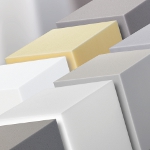 BASF has introduced Basotect® EcoBalanced melamine foam, a material that helps to reduce the product carbon footprint (PCF) of many sound-absorption applications in the transportation, building, and construction industries. This easy, drop-in solution has an up to 50% lower PCF than the respective BASF standard grades but demonstrates the same material performance. Applications include engine covers, wall and ceiling sound absorbers, HVAC parts, and air cleaners.
BASF has introduced Basotect® EcoBalanced melamine foam, a material that helps to reduce the product carbon footprint (PCF) of many sound-absorption applications in the transportation, building, and construction industries. This easy, drop-in solution has an up to 50% lower PCF than the respective BASF standard grades but demonstrates the same material performance. Applications include engine covers, wall and ceiling sound absorbers, HVAC parts, and air cleaners.
Learn more.
Fastest large-format SLA 3D printer in the world
 Built on Formlabs' next-generation Low Force Display print engine, the new Form 4L SLA 3D printer delivers unmatched reliability with a 99% print success rate compared to other SLA 3D printers. These benefits, combined with a build volume nearly 5x the size of Form 4, allow Form 4L users to solve big problems and print smaller parts at high volume. Large-scale prints finished in under six hours.
Built on Formlabs' next-generation Low Force Display print engine, the new Form 4L SLA 3D printer delivers unmatched reliability with a 99% print success rate compared to other SLA 3D printers. These benefits, combined with a build volume nearly 5x the size of Form 4, allow Form 4L users to solve big problems and print smaller parts at high volume. Large-scale prints finished in under six hours.
Learn more.
Keypad teardown and design insights with Autodesk and Xometry
 Take a deep dive into the second revision of the macro keypad developed for Autodesk University's Factory Experience 2024 in this exclusive, on-demand webinar hosted by Xometry's Greg Paulsen and Autodesk Fusion's Jonathan Odom. This presentation features a live teardown of the keypad, showcasing how the design team addressed challenges and elevated the product. No registration required.
Take a deep dive into the second revision of the macro keypad developed for Autodesk University's Factory Experience 2024 in this exclusive, on-demand webinar hosted by Xometry's Greg Paulsen and Autodesk Fusion's Jonathan Odom. This presentation features a live teardown of the keypad, showcasing how the design team addressed challenges and elevated the product. No registration required.
Watch this Xometry webinar at your convenience.
Tube cutting and bending design guide: Xometry
 Xometry's no-cost tube design guide offers design tips and tricks for laser-cut tube parts, including: minimums, tolerances, and sizes. The guide also covers important rules for mandrel tube bending, such as tolerancing, distance between bends, bend center line radius, types of bends to avoid, and more. Incredibly handy. If you need parts, Xometry can help with that too. It's easy to get a quote.
Xometry's no-cost tube design guide offers design tips and tricks for laser-cut tube parts, including: minimums, tolerances, and sizes. The guide also covers important rules for mandrel tube bending, such as tolerancing, distance between bends, bend center line radius, types of bends to avoid, and more. Incredibly handy. If you need parts, Xometry can help with that too. It's easy to get a quote.
Learn more.
SPEE3D develops ultra-corrosion-resistant alloy
-- a game-changer for maritime additive manufacturing
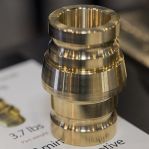 Australian manufacturer SPEE3D has developed two grades of an ultra-corrosion-resistant Nickel Aluminum Bronze alloy that are compatible with its Cold Spray Additive Manufacturing technology. The powder material is a game-changer for maritime OEMs and the U.S. Navy, as it will help with supply chain delays and keep critical maritime systems operational.
Australian manufacturer SPEE3D has developed two grades of an ultra-corrosion-resistant Nickel Aluminum Bronze alloy that are compatible with its Cold Spray Additive Manufacturing technology. The powder material is a game-changer for maritime OEMs and the U.S. Navy, as it will help with supply chain delays and keep critical maritime systems operational.
Read the full article.
New polymer bearings are PFAS- and PTFE-free
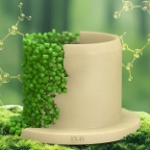 igus has developed a new polymer bearing material called iglide JPF that is free of both per- and polyfluoroalkyl substances (PFAS) and polytetrafluoroethylene (PTFE). This innovation marks an important step in the company's efforts to create sustainable alternatives to conventional plain bearings. JPF is a dry-running, wear-resistant polymer that offers comparable friction and wear performance to iglide J. It delivers high wear resistance and durability.
igus has developed a new polymer bearing material called iglide JPF that is free of both per- and polyfluoroalkyl substances (PFAS) and polytetrafluoroethylene (PTFE). This innovation marks an important step in the company's efforts to create sustainable alternatives to conventional plain bearings. JPF is a dry-running, wear-resistant polymer that offers comparable friction and wear performance to iglide J. It delivers high wear resistance and durability.
Learn more.
New high-speed PSLA 270 printer from 3D Systems
 The all-new PSLA 270 projector-based polymer 3D-printing platform and associated new materials from 3D Systems enable faster production times for a wide range of applications. This machine's high throughput and accuracy make it ideal for industries like healthcare, aerospace, automotive, and manufacturing, where precise and durable components are critical. Complementary Wash and Cure systems streamline post-processing and ensure high-quality finished parts.
The all-new PSLA 270 projector-based polymer 3D-printing platform and associated new materials from 3D Systems enable faster production times for a wide range of applications. This machine's high throughput and accuracy make it ideal for industries like healthcare, aerospace, automotive, and manufacturing, where precise and durable components are critical. Complementary Wash and Cure systems streamline post-processing and ensure high-quality finished parts.
Learn more including materials and build sizes.
Heat-resistant camouflage makeup aims to shield Soldiers from bomb blasts
Camouflage face makeup for warfare is undergoing one of the most fundamental changes in thousands of years, as scientists recently described a new face paint that both hides Soldiers from the enemy and shields their faces from the searing heat of bomb blasts. Firefighters also could benefit from the new heat-resistant makeup, according to the report.
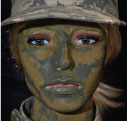
Image courtesy: Robert Lochhead]
It was part of a broader symposium on innovations in ingredients for personal care products held in August during the 244th National Meeting & Exposition of the American Chemical Society, the world's largest scientific society. The meeting included almost 8,600 reports on new discoveries in science and other topics.
Robert Lochhead, Ph.D., who presented the report, explained that Soldiers have used face paint for centuries for one kind of protection to help their skin blend in with the natural environment and shield them from enemies. The new material continues that tradition, but also provides protection from the searing heat of roadside bomb blasts and other explosions that have claimed a terrible toll in Iraq, Afghanistan, and other conflicts.
Video caption: Heat-reflective camouflage makeup made by Bob Lochhead and a team from the University of Southern Mississippi keeps the left-hand strip at below 100 degrees C after 10 sec under a blowtorch, whereas the unprotected strip reaches 400 degrees C.
"The detonation of a roadside bomb or any other powerful explosive produces two dangerous blasts," Lochhead said. "First comes a blast wave of high pressure that spreads out at supersonic speeds and can cause devastating internal injuries. A thermal blast follows almost instantaneously. It is a wave of heat that exceeds 1,112 degrees F. That's as hot as a burning cigarette. The thermal blast lasts only two seconds, but it can literally cook the face, hands and other exposed skin."
In an effort to protect soldiers from this threat, the U.S. Department of Defense has been seeking a solution that Lochhead initially regarded as an impossibility: A material that Soldiers could smear on their faces like suntan lotion, leaving a coating that although thinner than a sheet of paper, could protect against that intense heat. Dr. Paige Buchanan, Kelli Booth, Michelle McClusky, Laura Anderson, and Lochhead were the team that tackled the challenge. Not only did they succeed, but they discovered a formulation that protects in laboratory experiments way beyond the 2-sec heat-wave threat from improvised explosive devices and other bombs.
The new camouflage makeup protects the face and hands for up to 15 sec before its own temperature rises to the point where a first-degree burn, which is a mild burn, might occur. In some tests, the new face paint can protect for up to 60 sec, which could be important in giving Soldiers time to move away from blast-related fires and also for use by civilian firefighters.
The makeup had to meet several key criteria: It had to reflect intense heat; have camouflage colors suitable for day and night use; be easy to apply and remove; be waterproof; and be non-irritating to the eyes, nose, and mouth.
The trickiest part was that the University of Southern Mississippi team had to avoid the use of mineral oil, mineral spirits, fatty substances, and other traditional hydrocarbon makeup ingredients. Hydrocarbons can burn in contact with intense heat in the flame spectrum. The team turned to silicones, which are not as flammable because they absorb radiation at wavelengths outside of the intense heat spectrum. Silicones have been replacing hydrocarbons in many commercial cosmetic makeup products as cosmetics companies improve products to confer better feel properties and transfer resistance.
Another challenge was adding DEET, an insect repellent. The military mandates that all camouflage makeups contain 35% DEET. "DEET also is flammable, so when the Department of Defense asked us to incorporate it, we didn't think we could do it," Lochhead said. But the team successfully included DEET by encapsulating it in a hydrogel substance, a water-rich material that prevented DEET from catching fire.
It already has passed the preliminary laboratory tests needed to determine whether development should continue. Lochhead's team also plans tests of the material on other surfaces to try to protect clothing, tents, and other items from burning, and a colorless version is being developed for firefighters.
Source: ACS
Published September 2012
Rate this article
View our terms of use and privacy policy
